HUMMINGBIRD FLOWERS,
EARLY SPRING EDITION
Mild March weather in 2012 seems to have had an effect on the phenology of some animals and flora, with various native vegetation flowering a bit ahead of schedule, birds nesting early, and Ruby-throated Hummingbirds (RTHU) showing up in northern states where they don't usually appear until late April or early May. As mentioned in last week's installment, ruby-throats undoubtedly left the tropics "on time" this year but upon arriving on the Gulf Coast found no cold weather to deter their dispersal into the northern U.S. 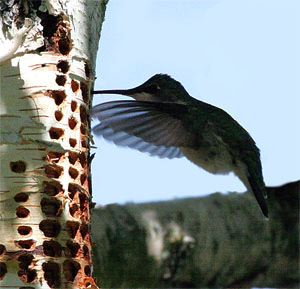 Historically, when RTHU moved north early they found few wildflowers from which to take nectar, so in some cases they visited trees scarred by sap-oozing holes created by Yellow-bellied Sapsuckers. These "sapsucker wells" (right) offer carbohydrates that provide quick energy for hummers while they seek out even more-nutritious insects--gnats, mosquitoes, fruit flies, aphids, and the like. Such tiny prey contain energy-rich fats that allow hummers to maintain basic metabolism; insects also provide amino acids (from proteins) needed as the hummer replenishes muscle cells worn out by the rigors of migration. Sapsucker wells obviously do provide food for early-arriving hummingbirds--the hummers also take small amounts of sap seeping from tree buds about to burst--but a smattering of native blossoms likewise provide a sugar fix. This week we offer a short list of wildflowers visited by hummers when they first return to the U.S. come March and April. Our list includes five species many folks in the eastern U.S. would do well to plant in their own backyard "Hummingbird Habitats" if they want to help meet the needs of early migrant hummers each spring. Historically, when RTHU moved north early they found few wildflowers from which to take nectar, so in some cases they visited trees scarred by sap-oozing holes created by Yellow-bellied Sapsuckers. These "sapsucker wells" (right) offer carbohydrates that provide quick energy for hummers while they seek out even more-nutritious insects--gnats, mosquitoes, fruit flies, aphids, and the like. Such tiny prey contain energy-rich fats that allow hummers to maintain basic metabolism; insects also provide amino acids (from proteins) needed as the hummer replenishes muscle cells worn out by the rigors of migration. Sapsucker wells obviously do provide food for early-arriving hummingbirds--the hummers also take small amounts of sap seeping from tree buds about to burst--but a smattering of native blossoms likewise provide a sugar fix. This week we offer a short list of wildflowers visited by hummers when they first return to the U.S. come March and April. Our list includes five species many folks in the eastern U.S. would do well to plant in their own backyard "Hummingbird Habitats" if they want to help meet the needs of early migrant hummers each spring.
All text & photos © Hilton Pond Center
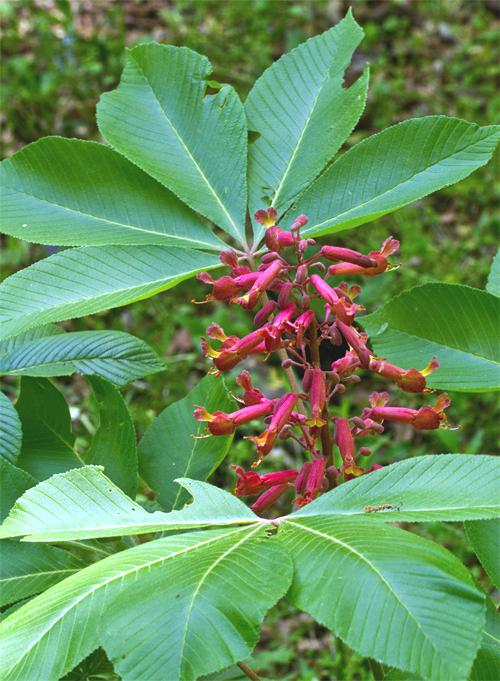
All text & photos © Hilton Pond Center
About six years ago we purchased from a native plant supplier a small shrub we had seen flowering profusely in the South Carolina Lowcountry in early spring. We knew this plant--Red Buckeye, Aesculus pavia--attracts migrant Ruby-throated Hummingbirds and wanted to try it here at Hilton Pond Center where we anticipated it would grow to a height of perhaps 15 feet and be covered each spring with red flowers. We also knew the foliage--five leaflets per leaf (above)--often drops off in late summer. We paid about $20 for a Red Buckeye in a one-gallon pot and following the advice of the late Bill Hilton Sr.--whose green thumb was highly regarded 'round these parts--dug "a five-dollar hole for a one-dollar plant." (In other words, we didn't just throw the buckeye into a haphazardly dug hole in the ground. Instead, we made the hole twice the width of the pot and then took the time to put in a handful of gravel for drainage. We carefully broke up the dirt ball to make sure the plant wasn't root-bound and amended the original soil with compost and humus before packing it gently around the buckeye's roots in the hole. Then we soaked the soil with water to drive out air bubbles and tamped it down once more, adding a bit more soil to bring it to the appropriate height on the buckeye's main stem. Bill Sr. would have been proud.)

All text & photos © Hilton Pond Center
Six years later what had been a one-foot-tall Red Buckeye sapling is now at the magnificent height of . . . two feet, and the darned thing has yet to bloom. However, three years ago we bought another foot-tall buckeye in a gallon pot and placed it beside the one in the ground. As we should have anticipated, this second plant--still in the pot, of course--has done extremely well and now dwarfs its predecessor at the towering height of four feet. More important, for the first time this spring the potted tree actually bloomed, producing two big clusters of nectar-rich tubular red flowers (above). We suspect other gardeners will have better luck with Red Buckeye than we did with our first attempt, so we suggest it as a species everyone in the eastern U.S. northwest to Illinois should try as an early flowering hummingbird plant. It'll even grow in Ontario! (NOTE: Red Buckeye can be hard to find, with local native plant nurseries being your best source. The species is sometimes called "Firecracker Plant." Please do NOT dig this or any other native plant in the wild to transplant unless the site is threatened by development. These days, stealing native plants from their native habitats is an unacceptable practice.)

All text & photos © Hilton Pond Center
One of our favorite spring wildflowers is Red Columbine, Aquilegia canadensis (above), which blooms here at Hilton Pond in late March--just when Ruby-throated Hummingbirds are beginning to return from their wintering grounds. Foraging hummers must hover directly beneath the flower, aiming their bills straight upward to sample the nectar that resides in a little bulb at the end of the flower spur. Columbines are perennials and have a tap root; they do best in rich, well-drained soil with sufficient moisture. We got ours from a native plant nursery but many folks have good success growing Red Columbine from seed; it flowers the second year and thrives almost everywhere in the eastern two-thirds of North America. (NOTE: Some eastern gardeners also like to grow western species of columbines that are blue or white. Our philosophy at Hilton Pond Center is to encourage and install local native plants rather than importing those from far-flung states or countries, so we have only Red Columbine. We try not to purchase from native plant nurseries more than 50 miles away, preferring to buy plants that are documented as having come out of the "local" gene pool. Buying locally also minimizes bringing in plant diseases from other parts of the country--especially when those plants are in pots surrounded by soil that might contain pathogens.)
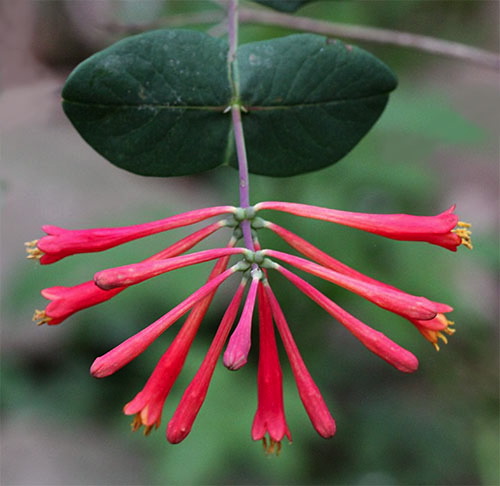
All text & photos © Hilton Pond Center
Trumpet Honeysuckle, Lonicera sempervirens (above)--AKA Coral Honeysuckle--may be our most-eagerly awaited early spring hummingbird flower. Here at Hilton Pond Center it blooms heavily beginning early as mid-March and continues for a month or so before resigning itself to vegetative growth. Then in late summer it blossoms once again, proving nectar for hummers as they're about to depart in fall migration. Certainly anything this red and this tubular has to be a hummingbird flower! Although this native is in the same genus as the invasive Japanese Honeysuckle, Lonicera japonica, we've never seen a hummingbird visit the latter. We suspect many folks who have had Trumpet Honeysuckle growing on their property--the vines propagate readily via berries carried by songbirds--have mistakenly destroyed them because they thought they had the Japanese invader. Foliage on the two vines is indeed similar, but to confirm Trumpet Honeysuckle look for perfoliate leaves (as shown above) with the vine growing through the bases of the leaves. This vine does well on a trellis or--as at Hilton Pond--twining among the dead branches of an Eastern Red Cedar snag we "planted" years ago as a support for various bird feeders.
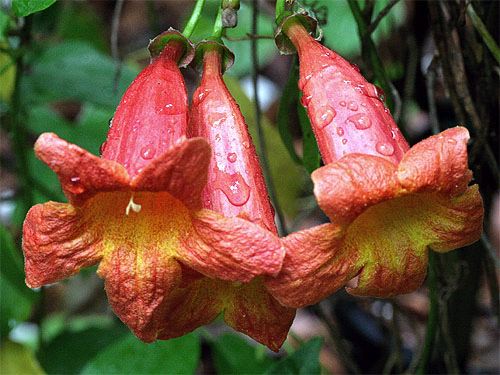
All text & photos © Hilton Pond Center
Last week we mentioned that Crossvine, Bignonia capreolata, was already flowering at Hilton Pond Center by the end of March. That generated some questions from visitors to our Web site, so we'll say a little more about this species. Crossvine is in the Bignoniaceae, the same family as the Catalpa tree and the Trumpet Creeper vine, Campsis radicans. Folks who follow our hummingbird work know we are enamored of Trumpet Creeper and its four-inch orange flowers that yield copious nectar consumed by Ruby-throated Hummingbirds during most of the breeding season. Problem is, Trumpet Creeper doesn't start blooming until about mid-May, so having the related and similarly endowed two-inch Crossvine flowers available in March-April provides a nice nectar snack for the first returning ruby-throats. Crossvine grows natively throughout the southeastern quarter of the U.S. and west as far as Texas. Like Trumpet Creeper, Crossvine often climbs a supportive tree, reaching heights of up to 50 feet, an altitude at which it's always interesting to see hummers feeding. This vine is non-deciduous, with leaves turning from dark green during the growing season to reddish-purple in winter--providing some nice color to the winter landscape.
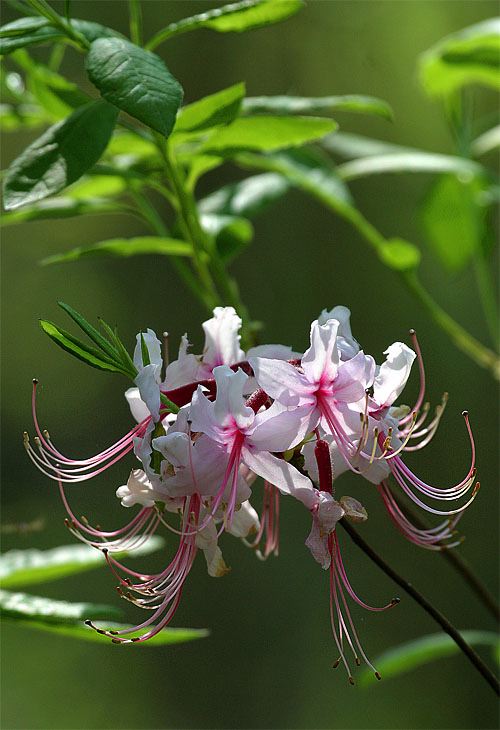
All text & photos © Hilton Pond Center
Southern gardeners--and groundskeepers at Augusta National Golf Club (home of the Masters)--take great pride in growing big showy azaleas that come in myriad hues from red to purple to pink to white. We, too, find these spring floral displays attractive, but nearly all the shrubs involved are Japanese Azaleas, hybridized and inbred for showy flowers that often lack any nectar whatsoever. We much prefer the native azaleas, especially Pinxter-flower, Rhododendron periclymenoides, which occurs from the Carolina Piedmont north to Vermont and as far west as Illinois. (We liked the plant's former species name nudiflorum because it referred to the shrub's tendency to flower while "nude," i.e., before leaves appear.) 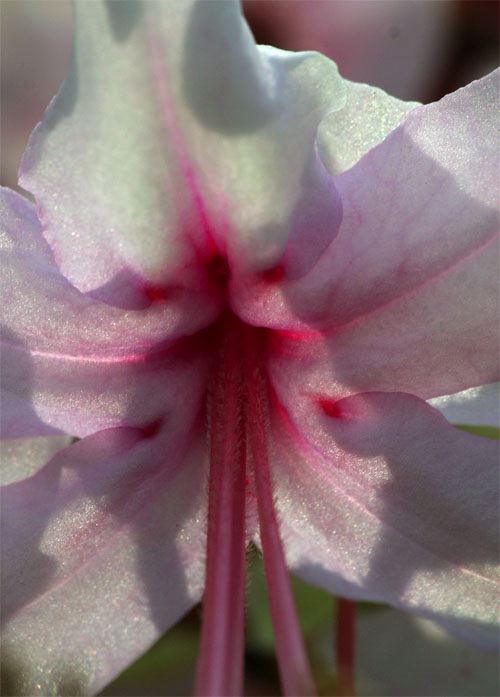 Similar wild azalea species grow in the Carolinas Coastal Plain and south to Florida. Although the long reproductive structures of Pinxter-flower suggest its primary pollinators are butterflies, Ruby-throated Hummingbirds frequently visit the shrub when few other plants are blooming. Similar wild azalea species grow in the Carolinas Coastal Plain and south to Florida. Although the long reproductive structures of Pinxter-flower suggest its primary pollinators are butterflies, Ruby-throated Hummingbirds frequently visit the shrub when few other plants are blooming.
So there you have it: Five early spring wildflowers that are easily propagated--well, maybe except for that Red Buckeye that gave us so much trouble!--and that should grow in most eastern states where Ruby-throated Hummingbirds occur. Your hummingbird habitat may contain a wide variety of nectar-rich flowers for ruby-throats to visit while they are present, but those included this week are special in that they blossom in early spring just as the hummers are coming back from the Neotropics. By all means hang a sugar water feeder to attract these tiny feathered migrants, but give all five early flowering plants a try if you want to get the attention of the first hummers to arrive in your yard each spring.
All text & photos © Hilton Pond Center

All contributions are tax-deductible
NATURE MOMENTS WITH McKINLEY
An occasional series of natural history encounters with and for Miss McKinley Ballard Hilton, born 1 May 2011 and already eager to explore the wonderful world of nature. As interpreted by her justifiably proud paternal grandfather.

All text & photos © Hilton Pond Center
McKinley photos courtesy April Carpenter
This Easter week our one and only granddaughter McKinley Ballard Hilton (above) celebrated her 11-month birthday (1 April) by being introduced to a baby sheep (AKA "lamb"), Ovis aries. Sheep are ungulates--hooved animals--and actually are cattle. Cattle have even numbers of toes per foot and are classified in Artiodactyla, the mammalian order that includes cows, deer, camels, giraffes, antelope, the little-known African Chevrotain, and pigs.  (Yes, pigs . . . and Peccaries . . . and Javelinas.) Lambs have cloven (split) hooves--which are actually modified toenails upon which they walk. For many folks, the most surprising member of the cattle family is the Hippopotamus, which has four toes and toenails per foot but no true hooves; it also doesn't chew a cud. The most prominent artidactylates in eastern North America these days are White-tailed Deer, historically outnumbered by another big native cow, the American Bison. Other hoofed animals--the horse, for example--have odd numbers of toes per foot and are placed in the Perissodactyla; cuds they do not chew. (McKinley also had her first encounter with peeps this week--above right--but that's a nature moment for another time.) (Yes, pigs . . . and Peccaries . . . and Javelinas.) Lambs have cloven (split) hooves--which are actually modified toenails upon which they walk. For many folks, the most surprising member of the cattle family is the Hippopotamus, which has four toes and toenails per foot but no true hooves; it also doesn't chew a cud. The most prominent artidactylates in eastern North America these days are White-tailed Deer, historically outnumbered by another big native cow, the American Bison. Other hoofed animals--the horse, for example--have odd numbers of toes per foot and are placed in the Perissodactyla; cuds they do not chew. (McKinley also had her first encounter with peeps this week--above right--but that's a nature moment for another time.)
All text & photos © Hilton Pond Center
|
 The Piedmont Naturalist, Volume 1 (1986)--long out-of-print--has been re-published by author Bill Hilton Jr. as an e-Book downloadable to read on your iPad, iPhone, Nook, Kindle, or desktop computer. Click on the image at left for information about ordering. All proceeds benefit education, research, and conservation work of Hilton Pond Center for Piedmont Natural History.
The Piedmont Naturalist, Volume 1 (1986)--long out-of-print--has been re-published by author Bill Hilton Jr. as an e-Book downloadable to read on your iPad, iPhone, Nook, Kindle, or desktop computer. Click on the image at left for information about ordering. All proceeds benefit education, research, and conservation work of Hilton Pond Center for Piedmont Natural History.

 Every new member who registers with iGive and makes a purchase through them earns an ADDITIONAL $5 for the Center. You can even do Web searches through iGive and earn a penny per search--sometimes TWO--for the cause!Please enroll by going to the iGive Web site. It's a painless, important way for YOU to support our on-going work in conservation, education, and research. Add the iGive Toolbar to your browser and register Operation RubyThroat as your preferred charity to make it even easier to help Hilton Pond Center when you shop.
Every new member who registers with iGive and makes a purchase through them earns an ADDITIONAL $5 for the Center. You can even do Web searches through iGive and earn a penny per search--sometimes TWO--for the cause!Please enroll by going to the iGive Web site. It's a painless, important way for YOU to support our on-going work in conservation, education, and research. Add the iGive Toolbar to your browser and register Operation RubyThroat as your preferred charity to make it even easier to help Hilton Pond Center when you shop.

 Historically, when RTHU moved north early they found few wildflowers from which to take nectar, so in some cases they visited trees scarred by sap-oozing holes created by Yellow-bellied Sapsuckers. These "sapsucker wells" (right) offer carbohydrates that provide quick energy for hummers while they seek out even more-nutritious insects--gnats, mosquitoes, fruit flies, aphids, and the like. Such tiny prey contain energy-rich fats that allow hummers to maintain basic metabolism; insects also provide amino acids
Historically, when RTHU moved north early they found few wildflowers from which to take nectar, so in some cases they visited trees scarred by sap-oozing holes created by Yellow-bellied Sapsuckers. These "sapsucker wells" (right) offer carbohydrates that provide quick energy for hummers while they seek out even more-nutritious insects--gnats, mosquitoes, fruit flies, aphids, and the like. Such tiny prey contain energy-rich fats that allow hummers to maintain basic metabolism; insects also provide amino acids 





 Similar wild azalea species grow in the Carolinas Coastal Plain and south to Florida. Although the long reproductive structures of Pinxter-flower suggest its primary pollinators are butterflies, Ruby-throated Hummingbirds frequently visit the shrub when few other plants are blooming.
Similar wild azalea species grow in the Carolinas Coastal Plain and south to Florida. Although the long reproductive structures of Pinxter-flower suggest its primary pollinators are butterflies, Ruby-throated Hummingbirds frequently visit the shrub when few other plants are blooming.


 Please report your sightings of
Please report your sightings of